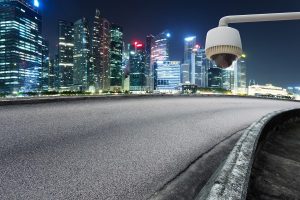Law enforcement agencies around the globe are beginning to rely more heavily on technology to assist in their roles to keep the peace. The use of CCTV cameras, and more recently, police robots, are aiding in many areas of law enforcement.
Over the past 10 + years, the United Kingdom has become the most watched citizenry in Europe. Since the early 1990’s, over one million closed circuit televisions (CCTV cameras) have been installed in towns and cities across Britain, with an estimated 500 or more being added weekly.
CCTV is designed to increase formal surveillance by making it easier for the police (or other agencies) to monitor the behavior of citizens (including potential offenders). CCTV is intended to deter crime by increasing the risk of detection for criminal behavior. CCTV footage can also be used to identify suspects in offenses that are committed within view of the camera. As a result, CCTV cameras can now be found in most urban areas, town squares and shopping centers. They can also be found in many offices, parking lots and in stores.
The video and images collected from the CCTV cameras can be stored and reviewed in case of a crime committed within their specific parameters of view. This gives law enforcement personnel the ability to use real-time surveillance when the crime may not have any eye-witnesses, or when there is conflicting information.
CCTV cameras are good for static surveillance, but, what if a crime didn’t take place in view? That is where the entrance of police robots come in.
In May of 2017, a robot that utilizes cameras, the internet and artificial intelligence was welcomed as a new member of the police force in Dubai.
The autonomous “Robocop” began duties by greeting guests at the opening of the 4th Gulf Information Security Expo and Conference (GISEC) on May 23 at the Dubai World Trade Center (DWTC). The robot stands nearly 70 in. tall and weighs nearly 220 lbs. and features an “emotion detector” which recognizes gestures and hand signals from up to 5 ft. away. The emotion detector is designed to detect if a person is happy, sad, or smiling, and can change its expression and greetings accordingly.
Robocop’s features also include the ability to map the inside of a building and navigate autonomously through its self-control and drive feature, as well as a built-in tablet that enables people to interact and even pay the robot for various services. It is also able to communicate in six languages, while also being able to respond to queries, shake hands, and even offer a military salute.
Police Robots are also designed to allow access to situations that are inaccessible or dangerous for first responders, or where more law enforcement presence is needed. For instance, the Cleveland Police had a few nonlethal ones on hand at the Republican National Convention in July of 2016.
“Robots and autonomous machines are shaping and redefining our future and transforming the way we function. Technological advancements are enabling robots to talk, see, feel and react to objects and humans. The age of the robots is no longer coming – it has arrived,” said Trixie LohMirmand, Senior Vice President, Exhibitions & Events Management, DWTC.
Universe Kogaku designs and manufactures optical lenses for CCTV cameras and robotic policing systems, security, high tech and electronic applications. We stock 1000’s of standard lens assemblies and can custom design a solution for scanners, CCTV, CCD/CMOS, medical imaging, surveillance systems, machine vision and night vision systems.